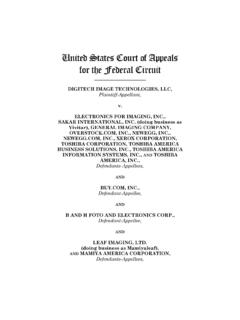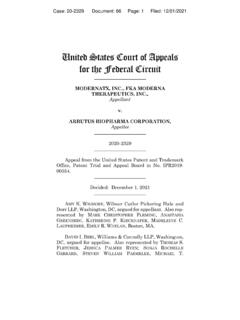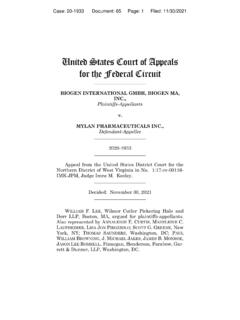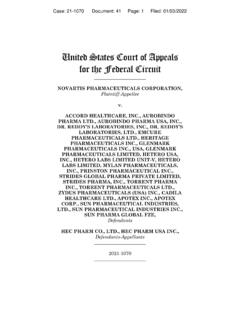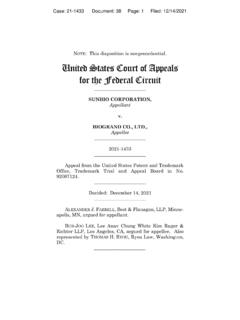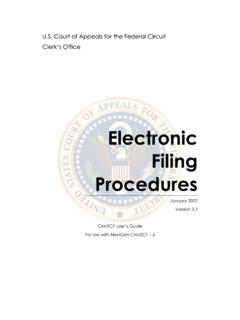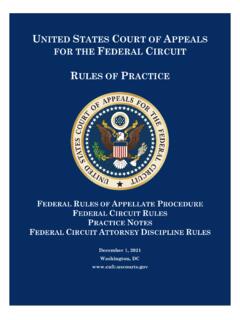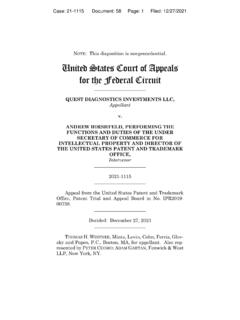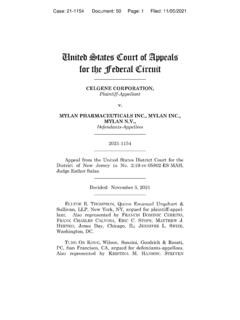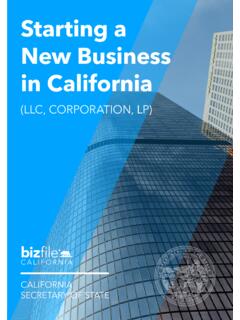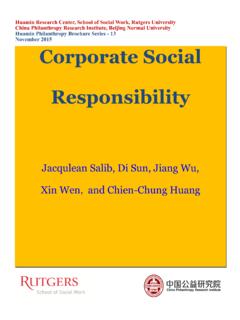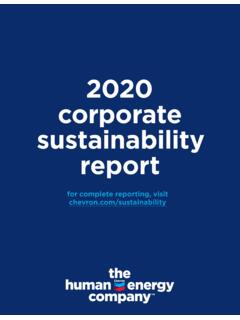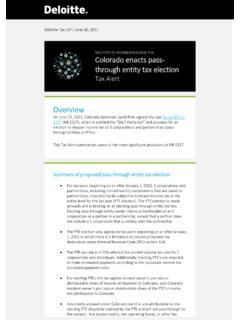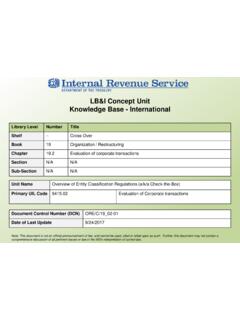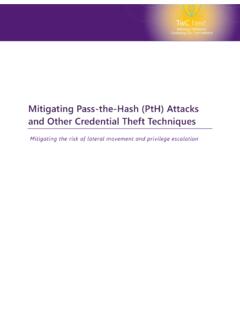Transcription of United States Court of Appeals for the Federal Circuit
1 United States Court of Appeals for the Federal Circuit _____ HOYT AUGUSTUS FLEMING, Appellant v. CIRRUS DESIGN CORPORATION, Appellee _____ 2021-1561 _____ Appeal from the United States Patent and Trademark Office, Patent Trial and Appeal Board in No. IPR2019-01566. _____ Decided: March 10, 2022 _____ MICHAEL S. DOWLER, Park, Vaughan, Fleming & Dow-ler LLP, Houston, TX, argued for appellant. KEVIN P. WAGNER, Faegre Drinker Biddle & Reath LLP, Minneapolis, MN, argued for appellee. Also repre-sented by VICTOR P. JONAS; JOEL SAYRES, JD SCHNEIDER, Denver, CO. _____ Before LOURIE, HUGHES, and STOLL, Circuit Judges.
2 STOLL, Circuit Judge. Case: 21-1561 Document: 49 Page: 1 Filed: 03/10/2022 FLEMING v. CIRRUS DESIGN CORP. 2 Hoyt Augustus Fleming Appeals the Patent Trial and Appeal Board s final written decision determining that the challenged claims of Patent No. RE47,474 a re un-patentable as obvious. Mr. Fleming also Appeals the Board s denial of his motion to amend certain claims. The Board determined the proposed amended claims lacked written description and were indefinite. We affirm the Board s obviousness determination and its denial of Mr. Fleming s motion to amend. BACKGROUND I The 474 patent describes ballistic parachute systems on aircraft.
3 474 patent, Abstract; id. col. 1 ll. 1 30. The specification explains that ballistic parachutes use a rocket to quickly deploy a parachute, slowing the fall of a crashing aircraft. See, , id. at col. 1 ll. 37 47. The chief benefit of a ballistic parachute is its speed in deploying a potential life-saving measure that slows the aircraft s descent. Not surprisingly, a ballistic parachute is most successful in slowing the descent of a failing aircraft when it can become fully inflated and functional. See id. at col. 1 ll. 46 47. As the specification explains, it takes time for a ballis-tic parachute to fully inflate and begin stabilizing an air-craft.
4 A higher aircraft altitude upon deployment of the parachute means there is more time for the parachute to deploy and slow the aircraft. Id. at col. 10 ll. 1 13. Even with a high deployment altitude, however, full stabilization can only be achieved if the parachute is deployed properly. See id. at col. 10 ll. 14 59. For example, if the parachute is deployed when the aircraft is upside down, the parachute is more likely to become tangled and nonfunctional. Id. at col. 10 ll. 44 52. And if the aircraft is moving too quickly, the parachute may simply rip away from the aircraft rather than inflating. See, , id. at col. 10 ll. 14 30.
5 The speci-fication discloses that it is preferred to reach key operating parameters like certain speed, altitude, and pitch Case: 21-1561 Document: 49 Page: 2 Filed: 03/10/2022 FLEMING v. CIRRUS DESIGN CORP. 3 before (or, if time requires, while) deploying a ballistic par-achute. See id. at col. 9 l. 61 col. 10 l. 59. The 474 patent is directed to a subset of these systems, termed intelligent ballistic parachute systems. Id. Title, Abstract (emphasis added). The specification explains that the disclosed intelligent ballistic parachute system is capa-ble of performing pre-activation and post-activation ac-tions, , actions taking place before or after the ballistic parachute is activated.
6 Id. at col. 9 l. 61 col. 13 l. 38. Such pre- and post-activation actions may include instructing the aircraft to: (1) turn or increase altitude, id. at col. 11 ll. 43 46; (2) fly at a level attitude, id. at col. 11 ll. 47 49; (3) reduce speed, id. at col. 11 ll. 20 33; or (4) enable or dis-able reefing control, which controls the inflation time of the parachute, id. at col. 8 l. 63 col. 9 l. 2. These actions are intended to help the aircraft reach desired operating parameters for deploying a ballistic parachute without the direct involvement of a pilot. Id. at col. 11 ll. 6 56. Specifically, the 474 patent discloses that, upon receiv-ing a parachute activation request from an activation in-terface, one or more processors determine whether a pre-activation action must be performed before deploying the parachute.
7 Id. at col. 54 ll. 24, 29, 40 46; see also id. at col. 9 l. 61 col. 11 l. 56, Fig. 14. If so, the processors com-mand performance of the pre-activation action. Id. at col. 11 ll. 50 56; see also, , id. at col. 54 ll. 40 52. The processors may also command performance of a post-acti-vation action. Id. at col. 11 ll. 57 59. Although not claimed, the 474 patent written descrip-tion also contemplates the optional inclusion of an intelli-gence override interface. Id. at col. 8 ll. 36 39, 50 62. This interface allows an aircraft occupant to manually by-pass the processor-controlled operations to immediately de-ploy the parachute, for example by pulling a pull-handle or pressing a button.
8 Id. at col. 8 ll. 50 62. Case: 21-1561 Document: 49 Page: 3 Filed: 03/10/2022 FLEMING v. CIRRUS DESIGN CORP. 4 The original claims of the 474 patent at issue in this appeal are claims 137 139. Claim 137 is representative: 137. An aircraft, the aircraft including: a fuselage; a whole-aircraft ballistic parachute, which includes a rocket, that is coupled to the fuselage of the air-craft, an activation interface, a pitch sensor, an autopilot, one or more memories having machine-readable in-structions stored thereon, and one or more processors, each of the one or more pro-cessors configured to read and execute a portion of the machine-readable instructions.
9 Wherein at least one of the one or more processors is coupled to the activation interface, at least one of the one or more processors is coupled to the pitch sensor, at least one of the one or more processors is coupled to the autopilot, at least one of the one or more processors is coupled to the rocket, at least one of the one or more processors is coupled to the one or more memories; the aircraft configured to perform a method com-prising: receiving, by the activation interface, a whole-air-craft ballistic parachute deployment request from an occupant of the aircraft; then based upon the re-ceipt of the whole-aircraft ballistic parachute de-ployment request by the activation interface, both performing an action and also deploying the whole-aircraft ballistic parachute; Case: 21-1561 Document: 49 Page: 4 Filed: 03/10/2022 FLEMING v.
10 CIRRUS DESIGN CORP. 5 wherein the machine readable-instructions include the action comprising: based at least upon the receipt of the whole-aircraft ballistic parachute deployment request, command the autopilot to increase aircraft pitch. Id. at col. 54 ll. 20 51. Claims 138 and 139 are identical except for the final phrase describing the action to be taken upon receipt of the parachute deployment request. In claim 138, the autopilot is commanded to reduce aircraft roll, and in claim 139 it is commanded to change the atti-tude of the aircraft. Id. at col. 54 l. 52 col. 55 l. 17, col. 55 l. 18 col. 56 l. 25. II In its final written decision, the Board determined that claims 137 139 of the 474 patent would have been obvious over a combination of Cirrus Design s Pilot Operation Handbook for the SR22, Revision A7, (Oct.)
